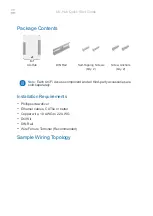
VPP2-06-xV/xx-CE1017_Instruction manual for the use of_Gebrauchsanweisung_Návod k použití__29426400_2en_de_cz_09/2021
Page 5
www.argo-hytos.com
The valve consists of housing (1), a cone with damping piston (2) and a spring (3). The pressure is adjusted by means of a screw (4). The set position
of the screw is secured by a nut (5). The spring pushes the cone into the seat (5) and holds the valve closed. If the system pressure in channel P rises
above the value set by the spring, the cone slides out of the seat and transfers fluid from channel P, connected to the hydraulic circuit, to channel T,
connected to the tank, until the pressure drops again. Due to the relatively high pressure loss of the valve, we do not recommend using the valve for
continuous pressure control. Energy losses and excessive heating of the working fluid occur. The adjusting screw is protected against unintentional
change of the cracking pressure setting by a plastic cap (7) with seal (8).
3. Product description
Valve body, seat, spring holder, adjusting screw, locking nut – low carbon steel
Cone (poppet) – direct hardened steel
Sealing – NBR, FPM, PU
Cover – PE
Compression spring– patented steel wire for the production of springs
The materials used are not listed in the lists of prohibited and mandatory documented substances of
Directive 2015/863/EU (RoHS) and EU regulation no. 1907/2006 (REACH).
3.1 Material used:
The valve surface is blackened or galvanized with 240 / 520 h corrosion in NSS according to ISO 9227.
The galvanizing surface protection does not contain hexavalent chromium Cr+6.
3.2 Surface protection against corrosion:
3.3 Basic technical parameters
Parameter
Unit
Value
Maximum pressure in inlet channel P
bar (PSI)
320 (4600)
Maximum volume flow through the valve
l/min (GPM)
50 (13)
Maximum internal volume loss of the closed valve when reducing
inlet pressure to 80% of the set opening pressure
cm
3
/min
0.1
Working fluid temperature range for NBR, PU sealing material
°C (°F)
-30 ... + 100 (-22...212)
Working fluid temperature range for FPM sealing material
°C (°F)
- 20 ... +120 (-4 ... 248)
Range of kinematic viscosity of the working fluid
mm
2
s
-1
10 ... 500
Required minimum purity of working fluid
class
21/18/15 ISO 4406
Lifespan
cycles
10
7
Weight
kg (lbs)
0.4 (0.88)
The valve is designed for common hydraulic working fluids:
› mineral oils of performance classes HM and HV according to ISO 6734-4
› non-flammable and highly flammable hydraulic fluids according to ISO 12922
› environmentally acceptable hydraulic fluids according to ISO 15380
3.4 Working fluid
3.5 Valve characteristics
Characteristics
measured at
ν
= 32 mm
2
/s (156 SUS)
Relief pressure related to flow rate
ATTENTION:
According to the seal manufacturer, the materials used may not be suitable for some glycol and ester based
working fluids. In case of uncertainty, we recommend performing a test of mutual tolerance on both the sealing
material and the working fluid.
0
10
20
30
40
50
20
40
60
80
(2.6)
(5.3)
(8.0)
(13.2)
(10.6)
(290)
(580)
(870)
(1160)
0
10
20
30
40
10
20
30
40
(2.6)
(5.3)
(8.0)
(10.6)
(145)
(290)
(435)
(580)
0
10
20
30
40
50
40
120
80
(2.6)
(5.3)
(8.0)
(13.2)
(10.6)
(580)
(1740)
(1160)
160
(2320)
Pressure range 6,3
Pressure range 2,5
Pressure range 10
Pr
essur
e p [bar (PSI)]
Flow Q [l/min (GPM)]
Flow Q [l/min (GPM)]
Flow Q [l/min (GPM)]






































